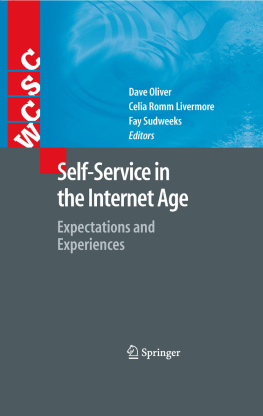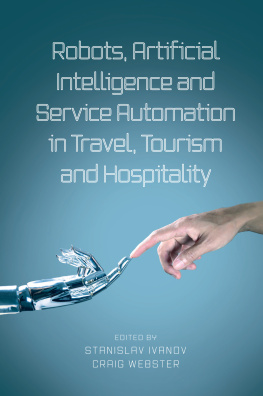1.1 Introduction
We define social networking websites as online services that focus on the building and verifying of social networks for whatever purpose. Indeed, social networking websites offer a range of services. Some are merely blog-hosting services, some offer the option of joining groups temporarily (through chat rooms) or for a longer period of time (through electronic bulletin boards, newsgroups, or online groups). Some social networking services encourage their members creativity through music and video sharing services or enable members to meet and possibly marry (eDating services).
The objective of this chapter is to discuss social networking and eDating services as emerging areas of self-service. To accomplish this goal, we will start by explaining in some detail what self-service is about. We will then proceed to discuss the reasons that social networking and eDating can be seen as examples of self-service. Next we will consider the business models on which the social networking and eDating industry is based, categorizing them according to a number of categories and subcategories. We will conclude this chapter with a discussion of the research and other implications from the discussion in this chapter.
1.2 What Is Self-Service?
Following Romm et al. (), we define self-service as a process in which aspects of the customer service experience that used to be provided by the companys employees are now provided through the interaction of customers with the companys website. Examples of self-service where customers perform functions that used to be performed by employees can be found in many new and long established industries. For example, in the past, grocery shopping involved shop employees retrieving items that customers wished to purchase. These days, when self-service is practiced, it is the customers who select their purchases, place them in a cart, and carry them to the cashier. It is expected that in the future, the process will be extended to include automatic scanning of purchases and automatic debiting of the customers bank account as they walk out of the store, without any direct involvement of store employees. Other industries where self-service is common are fast food, where waiters have been replaced by customers selecting and carrying their food to the table themselves; health, where new mothers are expected by hospitals to care for their new born babies as part of the rooming-in practice instead of having nurses care for them, as used to be the case several decades ago; and banking, where customers now conduct banking services through ATM machines.
A relatively recent development in the self-service area is for customers to be served online. Indeed, many companies establish an e-commerce presence (a company website) precisely because they consider a website a natural platform for self-service by their customers. This phenomenon is evident in many industries, for example, banking (where customers are encouraged to conduct transactions online) and travel (where customers can book flights and hotels online).
As indicated by a number of researchers, self-service websites can be categorized into two main types:
Informational websites . This type of website provides information about companies, services, or products. Many companies that offer informational websites (online newspapers, search engines, weather forecasting, etc) do not charge customers for their services. Instead, they generate profits through selling advertising services on their sites.
Transactional websites . This type of website involves an Internet-mediated transaction such as placing an order, making a bank transfer, or booking a flight. By conducting automated transactions through their websites, companies can greatly reduce the cost of transactions that were previously conducted by employees. For example, airlines can offer customers greatly reduced fares when they order tickets online, relative to the price of the same ticket ordered from a travel agent, through the telephone, or face-to-face.
As indicated in the previous sections, the proliferation of online self-service and the heavy investments that companies are willing to make to create the infrastructure that enables such services are motivated by expectations of profit. In other words, companies expect their short-term investment to eventually lead to long-term cost cutting.
However, the benefits from online self-service are also clear to customers. As indicated by Meuter et al. (), and others, consumers elect to avail themselves of self-service technologies for a number of reasons which are specific to them and not to the company that provides the service. These include:
ease of use
avoidance of service personnel
saving time
availability of the service when and where the consumer requires it
saving money
A recent investigation into the manner in which companies use their websites to support self-service by customers (Oliver et al. ) for measuring website content. The scale was applied to a sample of over 140 websites from more than 20 countries, measuring the extent to which the websites contained self-service features.
The results of the study indicated the following:
First, that industry made a difference to the extent to which self-service features were present in companies websites. Thus, while websites of companies in the construction and building industry contained few self-service features, websites in the gas and electricity industry (irrespective of culture) made extensive use of these features.
Second, the study indicated that culture made a difference. Thus, while English speaking countries, like the US, Canada, the UK, and Australia had a relatively large number of self-service features in their companies websites (irrespective of industry), developing countries were less likely to do so, again, irrespective of industry.
Finally, the study demonstrated that within the group of English-speaking countries (US, Canada, UK, and Australia), technology development has an impact on the prevalence of self-service features in a companys website, with the US, being the highest on the technology scale, also displaying more self-service features in its companies websites than the other countries.
It should be noted that social networking and eDating websites were not included in the above study. Still, as we will demonstrate in the following sections, at least some of the implications from the above research might be relevant and applicable to self-service in the social networking and eDating arena.






